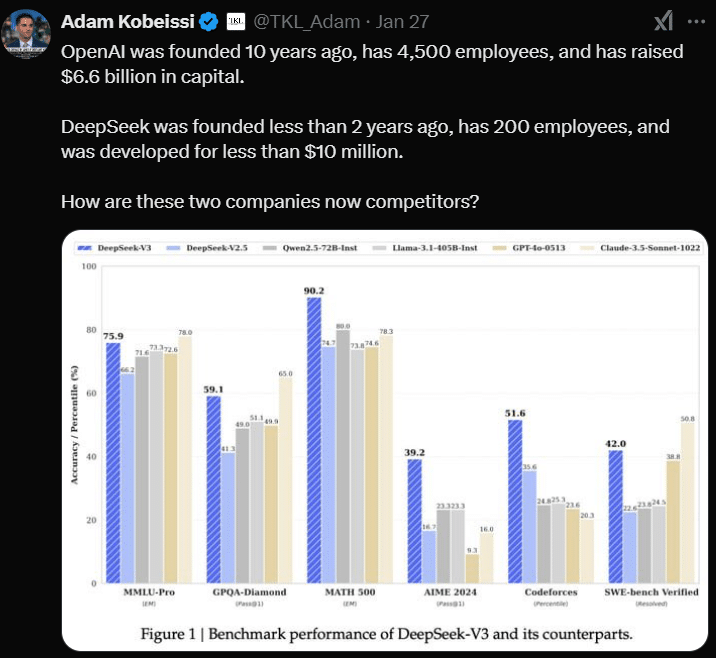In late 2023, a relatively unknown Chinese AI startup, DeepSeek, made headlines by releasing an AI model that rivals the capabilities of tech giants like Google and OpenAI. This breakthrough has sent shockwaves through the global tech sector, challenging assumptions about U.S. dominance in artificial intelligence and raising questions about the future of AI development.
What is DeepSeek?
DeepSeek is a Hangzhou-based AI startup founded in late 2023 by Liang Wenfeng, a serial entrepreneur with a background in hedge funds and technology investments. Liang is also the founder of High-Flyer, a hedge fund, and has a history of combining emerging technologies with investment strategies.
Before DeepSeek, Liang co-founded Hangzhou Jacobi Investment Management in 2013, a firm that used AI for trading strategies. He later established two more companies focused on computer-directed investments: Hangzhou Huanfang Technology Co in 2015 and Ningbo Huanfang Quantitative Investment Management Partnership in 2016.
Liang’s interest in AI stems from his curiosity about human intelligence and language. In a 2023 interview, he hypothesized that human thought might essentially be a linguistic process, suggesting that artificial general intelligence (AGI) could emerge from large language models.
DeepSeek’s Breakthrough: DeepSeek-R1
DeepSeek’s AI model, DeepSeek-R1, has been compared to OpenAI’s ChatGPT and Google’s AI models in terms of performance. What makes this achievement remarkable is the cost and resources involved.
According to a research paper released by DeepSeek’s development team, the company spent less than $6 million on computing power to train the model. This is a fraction of the multibillion-dollar budgets of U.S. tech giants like OpenAI, Alphabet, and Meta.
The team used approximately 2,000 Nvidia H800 chips, which are less advanced than the latest cutting-edge chips, to train DeepSeek-R1. By employing specialized models that work together, DeepSeek was able to optimize the efficiency of these chips, proving that high-performing AI models can be developed without the most advanced hardware.
Why DeepSeek’s Success Matters
DeepSeek’s success has raised existential questions about the approach to AI development in Silicon Valley and the U.S. government.
1. Challenging the Cost Barrier
U.S. tech firms have long been assumed to have a critical edge in AI due to their ability to invest massive sums in data centres, talent, and high-end chips. DeepSeek’s ability to develop a competitive AI model with limited resources challenges this assumption.
As Adam Kobeissi, founder of The Kobeissi Letter, noted on X:
“OpenAI was founded 10 years ago, has 4,500 employees, and has raised 6.6billionincapital.DeepSeekwasfoundedlessthan2yearsago,has200employees,andwasdevelopedforlessthan6.6billionincapital.DeepSeekwasfoundedlessthan2yearsago,has200employees,andwasdevelopedforlessthan10 million. How are these two companies now competitors?”

2. Impact on U.S. Chip Export Policies
The U.S. government has sought to contain China’s AI advancements by restricting the export of high-end chips. However, DeepSeek’s research suggests that either advanced chips are not essential for high-performing AI models or that Chinese firms can still source sufficient quantities of chips.
Before the U.S. imposed export restrictions in October 2023, DeepSeek had stockpiled 10,000 Nvidia A100 GPUs, ensuring they had the necessary hardware to continue their research.
3. A Wake-Up Call for Silicon Valley
DeepSeek’s emergence has been described as a “wake-up call” for the U.S. tech industry. Marc Andreessen, a prominent Silicon Valley venture capitalist, called it “AI’s Sputnik moment,” highlighting the need for the U.S. to remain laser-focused on innovation and competition.
Is China Winning the AI Race?
While DeepSeek’s achievements are impressive, it’s too early to declare China the leader in the AI race. The field is evolving rapidly, and U.S. companies like OpenAI continue to push the boundaries of AI development.
OpenAI CEO Sam Altman acknowledged DeepSeek-R1 as “impressive” but emphasized that his company remains focused on leveraging greater computing power to deliver even better models.
Rui Ma, founder of Tech Buzz China, noted that the Chinese tech sector was initially humbled by OpenAI’s release of ChatGPT in 2022. However, Chinese companies have since worked hard to catch up, as evidenced by DeepSeek’s breakthrough.
Lessons for the Global Tech Industry
DeepSeek’s success offers several key takeaways:
- Innovation Doesn’t Always Require Massive Resources
DeepSeek’s ability to develop a competitive AI model with limited resources demonstrates that innovation can thrive even without billion-dollar budgets. - The Importance of Open Access
Unlike OpenAI, which keeps its most advanced models behind paywalls, DeepSeek has made its best model freely available to the public. This approach has helped the company gain widespread recognition and user trust. - Global Collaboration Is Key
The rapid progress in AI development worldwide highlights the importance of collaboration and competition. Instead of focusing on suppressing competitors, countries should prioritize fostering innovation and talent.
Conclusion
DeepSeek’s rise is a testament to the power of ingenuity and resourcefulness in the tech world. By challenging the status quo, this Chinese startup has not only proven that high-performing AI models can be developed with limited resources but also sparked a global conversation about the future of AI innovation.
As the AI race heats up, one thing is clear: the game has changed, and the rules are being rewritten. Whether China or the U.S. takes the lead, the real winner will be the global tech community, driven by competition and the relentless pursuit of progress.
1 thought on “DeepSeek: The Chinese AI Startup Shaking Up the Global Tech Industry”